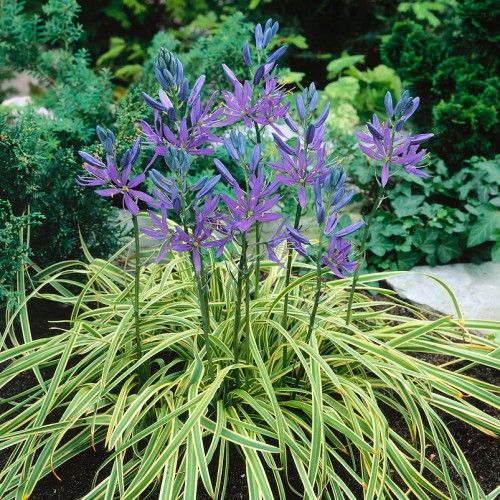
| Jan | Feb | Mar | Apr | May | Jun | Jul | Aug | Sep | Oct | Nov | Dec | |
|---|---|---|---|---|---|---|---|---|---|---|---|---|
| Planting | ||||||||||||
| Flowering | ||||||||||||
| Availability |
Camassia Quamash
Camassia quamash, widely recognised as common camas or blue camas, is a striking perennial flowering plant that belongs to the Asparagaceae family. This enchanting species is indigenous to the fertile valleys and coastal regions of western North America, often flourishing in nutrient-rich soils.
The plant is celebrated for its breathtaking clusters of star-shaped flowers, which bloom from spring to early summer in vibrant hues ranging from brilliant blue to deep purple, attracting various pollinators, such as bees and butterflies, with their enticing nectar. Its erect, slender foliage is characterised by long, grassy leaves that can grow up to 50cms in height, forming a lush green backdrop that accentuates the floral display.
Common camas typically inhabits moist meadows, open grasslands, and the edges of wetland areas, thriving in environments where water is readily available. Beyond its ornamental beauty, this plant holds profound cultural and historical significance, particularly among Indigenous peoples, who have harvested its edible bulbs for centuries. These bulbs, round and starchy, are rich in carbohydrates and have a sweet, nutty flavour when properly cooked. However, they contain a toxin called sapogenin, which requires careful preparation, often involving roasting or baking, to neutralise before consumption.
Thus, Camassia quamash not only adds beauty to its natural surroundings but also embodies the intricate connections between the land, its resources, and the cultures that have long revered it.
| Colour | Purple & Blue |
|---|---|
| Height | 30cm |
| Flowers | May/June |
| Planting Depth | 10cm |
| Distance Apart | 12cm |
| Bulb Size | 6/+cm |
